Evaluating Effects of Nitrogen and Phosphorus Discharges under Different Reduction Scenarios: A Case of Chaohu Lake Basin, China
Abstract
:1. Introduction
2. Materials and Methods
2.1. Study Area
2.2. Methods
2.2.1. Accounting for Point and Non-Point Source Pollution
- (1)
- Domestic sewage
- (2)
- Industrial sewage
- (3)
- Fertilizer runoff
- (4)
- Livestock breeding
- (5)
- Aquaculture
- (6)
- Atmospheric N deposition
2.2.2. Random Forest (RF) Model
2.2.3. Developing Scenarios
2.2.4. Parameter Uncertainty and Sensitivity Analysis
2.3. Statistical Analysis
3. Results and Discussion
3.1. Spatial–Temporal Distribution of N and P Discharge
3.2. Key Source Identification of N and P Discharge
3.3. Simulation of the N and P Discharge in the Basin
3.4. Evaluation of the N and P Discharge Reduction under Different Scenarios
4. Conclusions
- (1)
- Significant spatio-temporal distribution characteristics were obtained to determine the N and P discharge intensity and amount in the Chaohu Lake Basin.
- (2)
- The key sources of N and P discharge in the whole Chaohu Lake Basin were fertilizer application, domestic sewage, and livestock breeding. Agricultural activities were the key source of N and P discharge in this area (N: 53.75%; P: 59.29%).
- (3)
- The scenario simulation results show that the multi-factor strategy performed better than the single-factor and dual-factor ones. However, the effect of the discharge reduction measurements was different among the counties.
Supplementary Materials
Author Contributions
Funding
Data Availability Statement
Conflicts of Interest
References
- Yao, J.P.; Wang, G.Q.; Xue, B.L.; Wang, P.Z.; Hao, F.H.; Xie, G.; Peng, Y.B. Assessment of lake eutrophication using a novel multidimensional similarity cloud model. J. Environ. Manag. 2019, 248, 109259. [Google Scholar] [CrossRef]
- Li, A.; Strokal, M.; Bai, Z.H.; Kroeze, G.; Ma, L. How to avoid coastal eutrophication-a back-casting study for the North China Plain. Sci. Total Environ. 2019, 692, 676–690. [Google Scholar] [CrossRef] [PubMed]
- Du, H.B.; Chen, Z.N.; Mao, G.Z.; Chen, L.; Crittenden, J.; Li, R.Y.; Chai, L. Evaluation of eutrophication in freshwater lakes: A new non-equilibrium statistical approach. Ecol. Indic. 2019, 102, 686–692. [Google Scholar] [CrossRef]
- Shen, Z.Y.; Zhong, Y.C.; Huang, Q.; Chen, L. Identifying non-point source priority management areas in watersheds with multiple functional zones. Water Res. 2015, 68, 563–571. [Google Scholar] [CrossRef] [PubMed]
- Zong, M.; Hu, Y.M.; Liu, M.; Li, C.L.; Wang, C.; Liu, J.X. Quantifying the contribution of agricultural and urban non-point source pollutant loads in watershed with urban agglomeration. Water 2021, 13, 1385. [Google Scholar] [CrossRef]
- Lin, S.S.; Shen, S.L.; Zhou, A.; Lyu, H.M. Assessment and management of lake eutrophication: A case study in Lake Erhai, China. Sci. Total Environ. 2020, 751, 141618. [Google Scholar] [CrossRef] [PubMed]
- Fink, G.; Alcamo, J.; Florke, M.; Reder, K. Phosphorus loadings to the world’s largest lakes: Sources and trends. Global Biogeochem. Cycles 2018, 32, 617–634. [Google Scholar] [CrossRef]
- Barco, J.; Wong, K.M.; Stenstrom, M.K. Automatic Calibration of the U.S. EPA SWMM Model for a Large Urban Catchment. J. Hydraul. Eng. 2008, 134, 466–474. [Google Scholar] [CrossRef]
- Bouraoui, F.; Dillaha, T.A. ANSWERS-2000: Non-point-source nutrient planning model. J. Environ. Eng. 2000, 126, 1045–1055. [Google Scholar] [CrossRef]
- Young, R.A.; Onstad, C.A.; Bosch, D.D.; Anderson, W.P. AGNPS: A nonpoint-source pollution model for evaluating agricultural watersheds. J. Soil Water Conserv. 1989, 44, 168–173. [Google Scholar]
- Singh, N.K.; Gourevitch, J.D.; Wemple, B.C.; Watson, K.B.; Rizzo, D.M.; Polasky, S.; Ricketts, T.H. Optimizing wetland restoration to improve water quality at a regional scale. Environ. Res. Lett. 2019, 14, 64006. [Google Scholar] [CrossRef]
- Arnold, J.G.; Srinivasan, R.; Muttiah, R.S.; Williams, J.R. Large area hydrologic modeling and assessment part I: Model development. J. Am. Water Resour. Assoc. 1998, 34, 73–89. [Google Scholar] [CrossRef]
- Johnes, P.J. Evaluation and management of the impact of land use change on the nitrogen and phosphorus load delivered to surface waters: The export coefficient modelling approach. J. Hydrol. 1996, 83, 323–349. [Google Scholar] [CrossRef]
- Yazdi, M.N.; Ketabchy, M.; Sample, D.J.; Scott, D.; Liao, H.B. An evaluation of HSPF and SWMM for simulating streamflow regimes in an urban watershed. Environ. Model. Softw. 2019, 118, 211–225. [Google Scholar] [CrossRef]
- Moehansyah, H.; Maheshwari, B.L.; Armstrong, J. Field evaluation of selected soil erosion models for catchment management in Indonesia. Biosyst. Eng. 2004, 88, 491–506. [Google Scholar] [CrossRef]
- Singh, R.; Tiwari, K.N.; Mal, B.C. Hydrological studies for small watershed in India using the ANSWERS model. J. Hydrol. 2006, 318, 184–199. [Google Scholar] [CrossRef]
- Borah, D.K. Hydrologic procedures of storm event watershed models: A comprehensive review and comparison. Hydrol. Process. 2011, 25, 3472–3489. [Google Scholar] [CrossRef]
- Cong, W.C.; Sun, X.Y.; Guo, H.W.; Shan, R.F. Comparison of the SWAT and InVEST models to determine hydrological ecosystem service spatial patterns, priorities and trade-offs in a complex basin. Ecol. Indic. 2020, 112, 106089. [Google Scholar] [CrossRef]
- Wu, Z.S.; Lai, X.J.; Li, K.Y. Water quality assessment of rivers in Lake Chaohu Basin (China) using water quality index. Ecol. Indic. 2021, 121, 107021. [Google Scholar] [CrossRef]
- Gou, J.P.; Sun, L.Y.; Du, L.; Ma, H.X.; Xiong, T.X.; Ou, W.H.; Zhan, Y.Z. A representation coefficient-based k-nearest centroid neighbor classifier. Expert Syst. Appl. 2022, 194, 116529. [Google Scholar] [CrossRef]
- Cheng, X.; Chen, L.D.; Sun, R.H.; Jing, Y.C. An improved export coefficient model to estimate non-point source phosphorus pollution risks under complex precipitation and terrain conditions. Environ. Sci. Pollut. Res. Int. 2018, 25, 20946–20955. [Google Scholar] [CrossRef]
- Ding, X.W.; Shen, Z.Y.; Hong, Q.; Yang, Z.F.; Wu, X.; Liu, R.M. Development and test of the export coefficient model in the upper reach of the Yangtze River. J. Hydrol. 2010, 383, 233–244. [Google Scholar] [CrossRef]
- Chauhan, V.K.; Dahiya, K.; Sharma, A. Problem formulations and solvers in linear SVM: A review. Artif. Intell. Rev. 2019, 52, 803–855. [Google Scholar] [CrossRef]
- Sanchez, J.S.; Barandela, R.; Marques, A.I.; Alejo, R.; Badenas, J. Analysis of new techniques to obtain quality training sets. Pattern Recognit. Lett. 2003, 24, 1015–1022. [Google Scholar] [CrossRef]
- Breiman, L. Random forests, machine learning 45. J. Clin. Microbiol. 2001, 2, 199–228. [Google Scholar] [CrossRef]
- Duan, Y.Z.; Zou, B.; Xu, J.; Chen, F.; Wei, J.L.; Tang, Y.Y. OAA-SVM-MS: A fast and efficient multi-class classification algorithm. Neurocomputing 2021, 454, 448–460. [Google Scholar] [CrossRef]
- Guo, Y.Z.; Wang, X.Y.; Melching, C.; Nan, Z. Identification method and application of critical load contribution areas based on river retention effect. J. Environ. Manag. 2022, 305, 114314. [Google Scholar] [CrossRef]
- Speiser, J.L.; Miller, M.; Tooze, J.; Ip, E. A comparison of random forest variable selection methods for classification prediction modeling. Expert Syst. Appl. 2019, 134, 93–101. [Google Scholar] [CrossRef]
- Xu, M.Q.; Cao, H.; Xie, P.; Deng, D.G.; Feng, W.S.; Xu, J. The temporal and spatial distribution, composition and abundance of Protozoa in Chaohu Lake, China: Relationship with eutrophication. Eur. J. Protistol. 2005, 41, 183–192. [Google Scholar] [CrossRef]
- Yang, L.B.; Lei, K.; Meng, W.; Fu, G.; Yan, W.J. Temporal and spatial changes in nutrients and chlorophyll-α in a shallow lake, Lake Chaohu, China: An 11-year investigation. J. Environ. Sci. 2013, 25, 1117–1123. [Google Scholar] [CrossRef]
- Yang, X.; Cui, H.B.; Liu, X.S.; Wu, Q.; Zhang, H. Water pollution characteristics and analysis of Chaohu Lake basin by using different assessment methods. Environ. Sci. Pollut. Res. Int. 2020, 27, 18168–18181. [Google Scholar] [CrossRef]
- Fang, T.; Lu, W.X.; Jing, L.; Zhao, X.X.; Yang, K. Levels and risk assessment of metals in sediment and fish from Chaohu Lake, Anhui Province, China. Environ. Sci. Pollut. Res. Int. 2017, 24, 15390–15400. [Google Scholar] [CrossRef] [PubMed]
- Hu, Y.M.; Peng, Z.L.; Zhang, Y.H.; Liu, G.; Zhang, H.; Hu, W.P. Air temperature effects on nitrogen and phosphorus concentration in Lake Chaohu and adjacent inflowing rivers. Aquat. Sci. 2022, 84, 33. [Google Scholar] [CrossRef]
- Peng, Z.L.; Hu, W.P.; Zhang, Y.H.; Liu, G.; Zhang, H.; Gao, R. Modelling the effects of joint operations of water transfer project and lake sluice on circulation and water quality of a large shallow lake. J. Hydrol. 2020, 593, 125881. [Google Scholar] [CrossRef]
- GB 3838-2002; Environmental Quality Standards for Surface Water. Standardization Administration: Beijing China, 2002.
- MEP. Handbook of Accounting Methods and Coefficients for Emissions from Statistical Investigation of Emission Sources; Ministry of Ecology and Environment: Beijing, China, 2021. Available online: http://www.mee.gov.cn (accessed on 2 October 2023).
- NDRC. The 14th Five-Year Plan for the Construction of a Water-Saving Society; National Development and Reform Commission: Beijing, China, 2021. Available online: https://www.ndrc.gov.cn/ (accessed on 2 October 2023).
- Hu, S.B. Research on Nitrogen and Phosphorus Loss in Wheat-Rice Rotation in Chao Lake Basin under Different Fertilization; Anhui Agricultural University: Hefei, China, 2014. [Google Scholar]
- Wang, G.L.; Ma, Y.H.; Sun, X.W.; Song, F.L.; Xiao, S.H. Study of nitrogen and phosphorus runoff in wheat—Rice rotation farmland in Chao Lake Basin. J. Soil Water Conserv. 2010, 24, 6–10. [Google Scholar] [CrossRef]
- Yang, L.; Zhang, M.; Wei, J.; Qi, J. Pollution load estimation and control countermeasures of Zhangze reservoir. Front. Environ. Sci. 2022, 10, 874124. [Google Scholar] [CrossRef]
- AHAA. Anhui Province’s 13th Five Year Plan for the Development of Animal Husbandry; Department of Agriculture and Rural Affairs of Anhui Province: Hefei, China, 2016. Available online: http://nync.ah.gov.cn/ (accessed on 2 October 2023).
- Xu, W.; Luo, X.S.; Pan, Y.P.; Zhang, L.; Tang, A.H.; Shen, J.L.; Zhang, Y.; Li, K.H.; Wu, Q.H.; Yang, D.W.; et al. Quantifying atmospheric nitrogen deposition through a nationwide monitoring network across China. Atmos. Chem. Phys. 2015, 15, 12345–12360. [Google Scholar] [CrossRef]
- Wen, Z.; Xu, W.; Li, Q.; Han, M.J.; Tang, A.H.; Zhang, Y.; Luo, X.S.; Shen, J.L.; Wang, W.; Li, M.J.; et al. Changes of nitrogen deposition in China from 1980 to 2018. Environ. Int. 2020, 144, 106022. [Google Scholar] [CrossRef]
- Zhang, Q.; Li, Y.A.; Wang, M.R.; Wang, K.; Meng, F.L.; Liu, L.; Zhao, Y.H.; Ma, L.; Zhu, Q.C.; Xu, W.; et al. Atmospheric nitrogen deposition: A review of quantification methods and its spatial pattern derived from the global monitoring networks. Ecotoxicol. Environ. Saf. 2021, 216, 112180. [Google Scholar] [CrossRef]
- Rodriguez-Galiano, V.; Mendes, M.P.; Garcia-Soldado, M.J.; Chica-Olmo, M.; Ribeiro, L. Predictive modeling of groundwater nitrate pollution using Random Forest and multisource variables related to intrinsic and specific vulnerability: A case study in an agricultural setting (Southern Spain). Sci. Total Environ. 2014, 476–477, 189–206. [Google Scholar] [CrossRef]
- Baudron, P.; Alonso-Sarría, F.; García-Aróstegui, J.L.; Cánovas-García, F.; Martínez-Vicente, D.; Moreno-Brotóns, J. Identifying the origin of groundwater samples in a multi-layer aquifer system with Random Forest classification. J. Hydraul. 2013, 499, 303–315. [Google Scholar] [CrossRef]
- Ficklin, D.L.; Luo, Y.; Stewart, I.T.; Maurer, E.P. Development and application of a hydro-climatological stream temperature model within the soil and water assessment too. Water Resour. Res. 2012, 48, 308–316. [Google Scholar] [CrossRef]
- Wang, F.F.; Liu, S.L.; Liu, Y.X.; Sun, Y.X.; Yu, L.; Wang, Q.B.; Dong, Y.H.; Beazley, R. Long-term dynamics of nitrogen flow in a typical agricultural and pastoral region on the Qinghai-Tibet Plateau and its optimization strategy. Environ. Pollut. 2021, 288, 117684. [Google Scholar] [CrossRef] [PubMed]
- Pei, W.; Yan, T.Z.; Lei, Q.L.; Zhang, T.P.; Fan, B.Q.; Do, X.Z.; Luo, J.F.; Lindsey, S.; Liu, H.B. Spatio-temporal variation of net anthropogenic nitrogen inputs (NANI) from 1991 to 2019 and its impacts analysis from parameters in Northwest China. J. Environ. Manag. 2022, 321, 115996. [Google Scholar] [CrossRef] [PubMed]
- Wang, F.F.; Wang, Y.H.; Cai, Z.C.; Chen, X. Environmental losses and driving forces of nitrogen flow in two agricultural towns of Hebei province during 1997–2017. Environ. Pollut. 2020, 264, 114636. [Google Scholar] [CrossRef]
- Li, C.L.; Zhang, P.; Zhu, G.W.; Chen, C.; Wang, Y.C.; Zhu, M.Y.; Xu, H.; Jiang, C.L.; Zou, W.; Shi, P.C.; et al. Dynamics of nitrogen and phosphorus profile and its driving forces in a subtropical deep reservoir. Environ. Sci. Pollut. Res. Int. 2022, 29, 27738–27748. [Google Scholar] [CrossRef] [PubMed]
- Zhang, M.; Kong, F.X. The process, spatial and temporal distributions and mitigation strategies of the eutrophication of Lake Chaohu (1984–2013). J. Lake Sci. 2015, 27, 791–798. [Google Scholar] [CrossRef]
- Jiang, S.Y.; Hua, H.; Jarvie, H.P.; Liu, X.W.; Zhang, Y.; Sheng, H.; Liu, X.; Zhang, L.; Yuan, Z.W. Enhanced nitrogen and phosphorus flows in a mixed land use basin: Drivers and consequences. J. Clean. Prod. 2018, 181, 416–425. [Google Scholar] [CrossRef]
- Yang, N.; Zhang, C.; Wang, L.Q.; Li, Y.; Zhang, W.L.; Niu, L.H.; Zhang, H.J.; Wang, L.F. Nitrogen cycling processes and the role of multi-trophic microbiota in dam-induced river-reservoir systems. Water Res. 2021, 206, 117730. [Google Scholar] [CrossRef]
- Jia, L.X.; Zhou, Q.; Li, Y.W.; Wu, W.Z. Integrated treatment of suburb diffuse pollution using large-scale multistage constructed wetlands based on novel solid carbon: Nutrients removal and microbial interactions. J. Environ. Manag. 2023, 326, 116709. [Google Scholar] [CrossRef]
- Ma, Z.B.; Ni, H.G.; Zeng, H.; Wei, J.B. Function formula for first flush analysis in mixed watersheds: A comparison of power and polynomial methods. J. Hydrol. 2011, 402, 333–339. [Google Scholar] [CrossRef]
- Li, L.Q.; Yin, C.Q.; He, Q.C.; Kong, L.L. First flush of storm runoff pollution from an urban catchment in China. J. Environ. Sci. 2007, 19, 295–299. [Google Scholar] [CrossRef] [PubMed]
- Smith, D.R.; Warnemuende, E.A.; Haggard, B.E.; Huang, C. Changes in sediment-water column phosphorus interactions following sediment disturbance. Ecol. Eng. 2006, 27, 71–78. [Google Scholar] [CrossRef]
- Wang, S.R.; Jin, X.C.; Zhao, H.C.; Wu, F.C. Phosphorus release characteristics of different trophic lake sediments under simulative disturbing conditions. J. Hazard. Mater. 2009, 161, 1551–1559. [Google Scholar] [CrossRef]
- Nobes, K.; Uthicke, S.; Henderson, R. Is light the limiting factor for the distribution of benthic symbiont bearing foraminifera on the Great Barrier Reef. J. Exp. Mar. Biol. Ecol. 2008, 363, 48–57. [Google Scholar] [CrossRef]
- Wang, Y.P.; Xu, W.W.; Han, C.; Hu, W.P. Distribution of Nitrogen and Phosphorus in Lake Chaohu Sediments and Pollution Evaluation. Environ. Sci. 2020, 42, 699–711. [Google Scholar] [CrossRef]
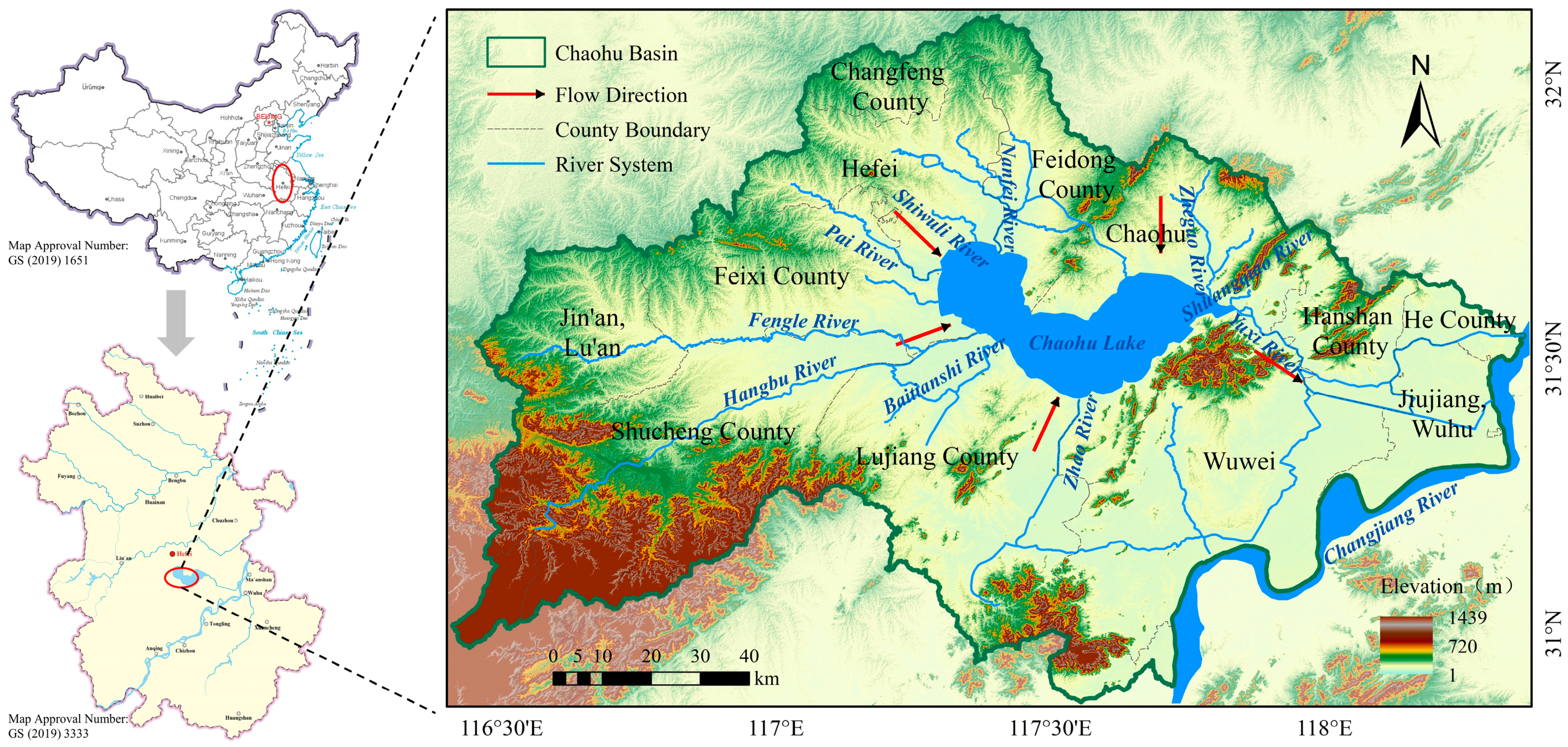
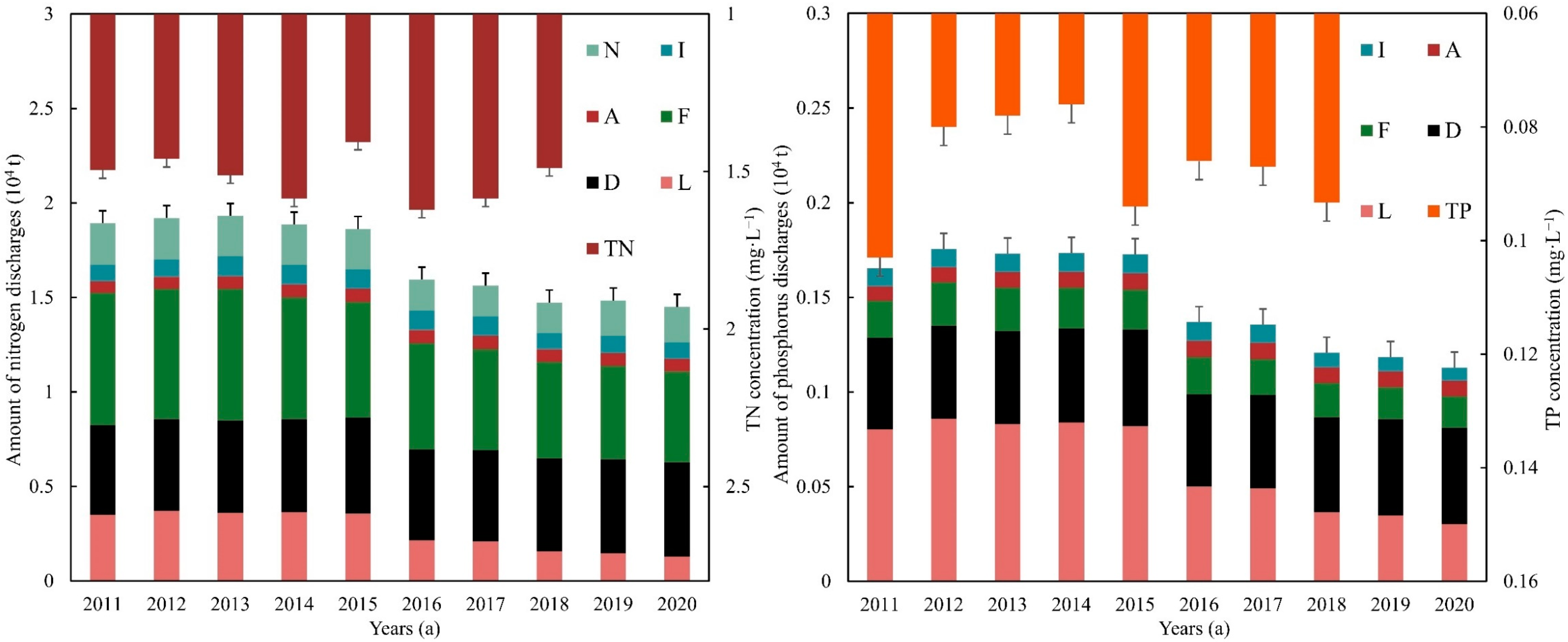
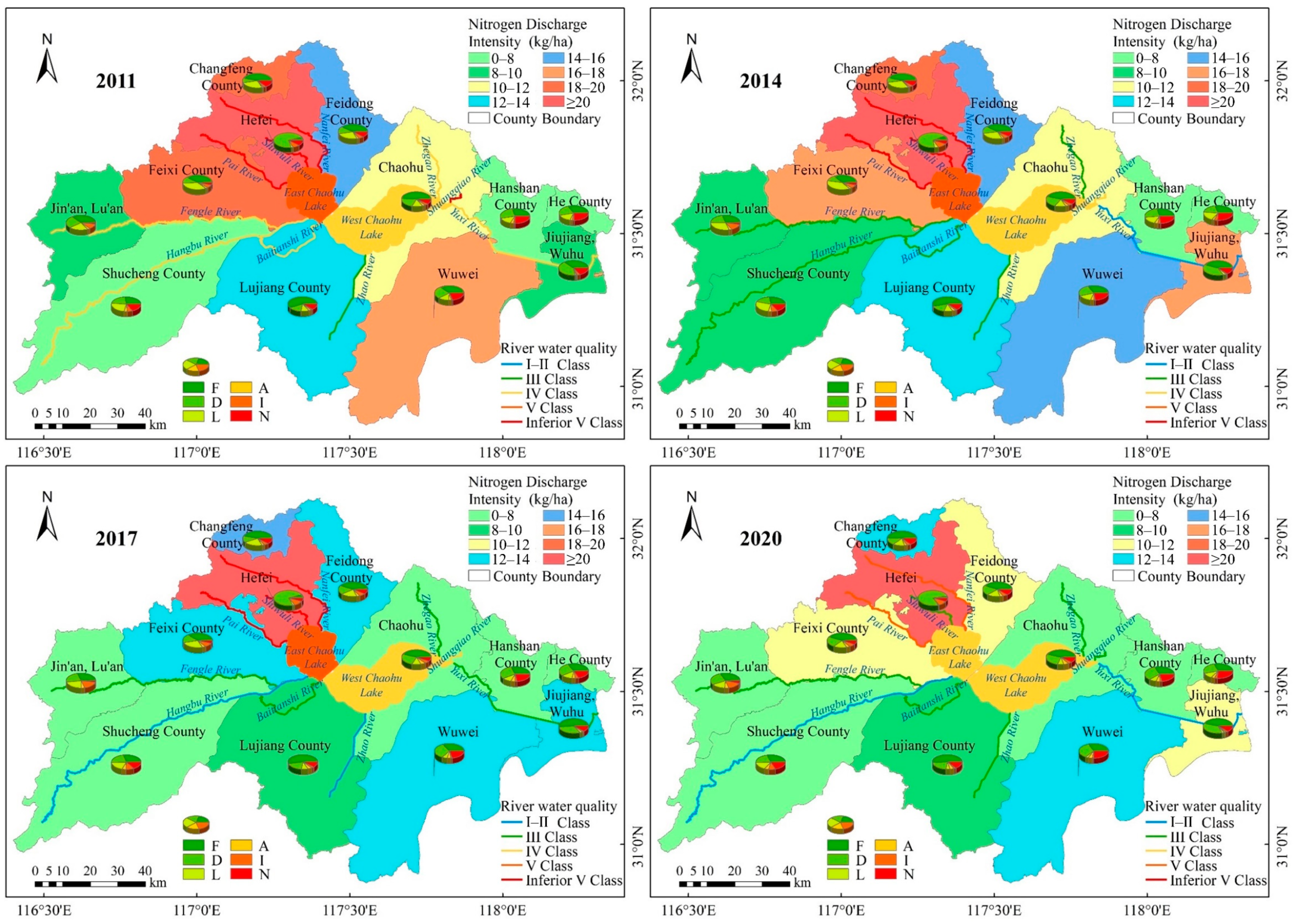
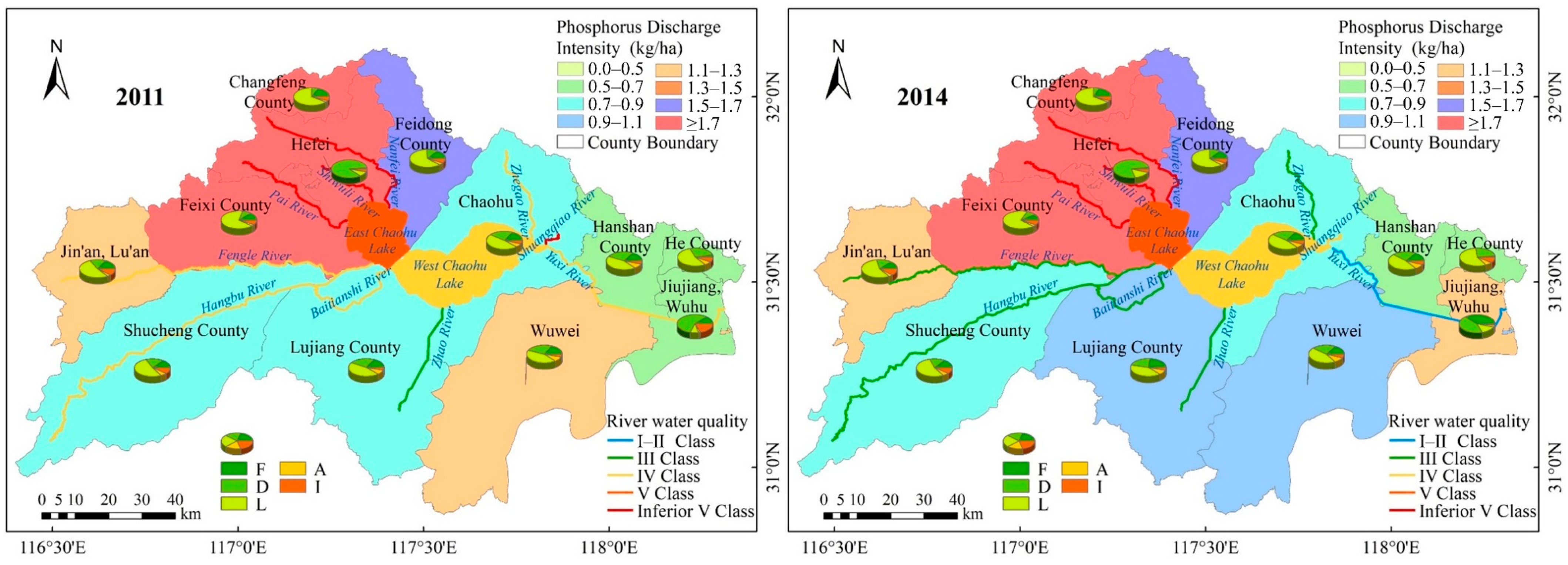
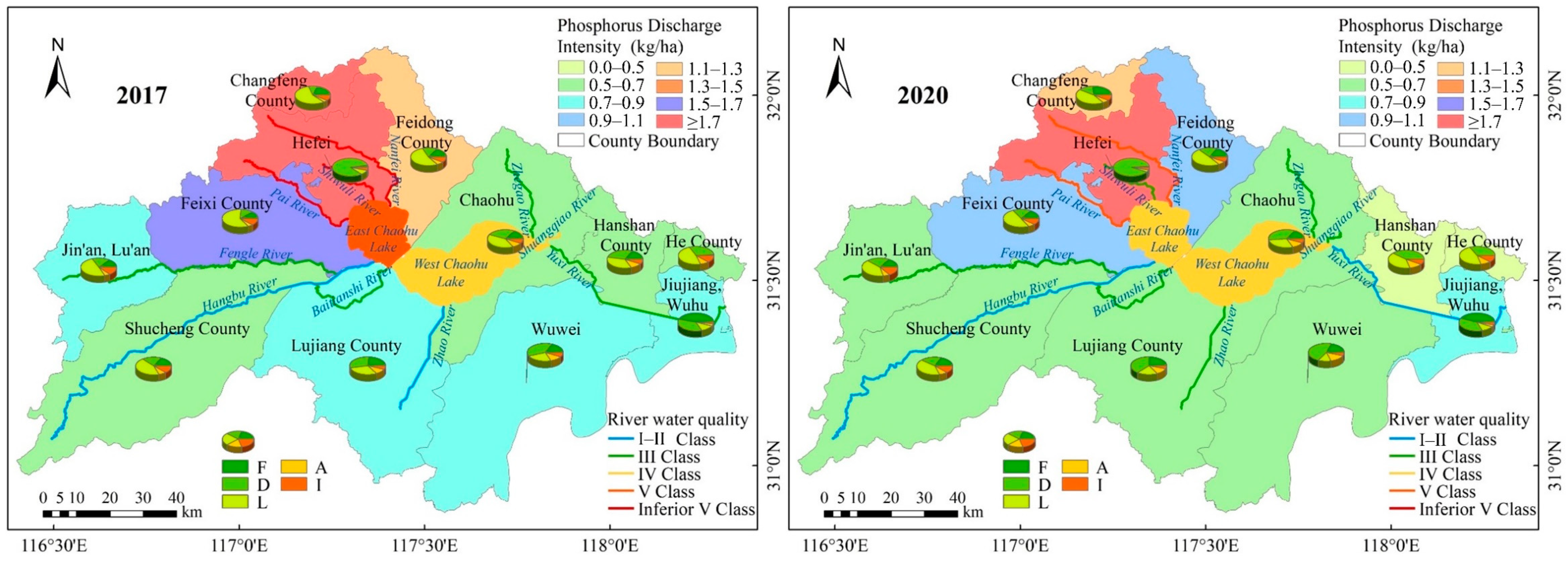
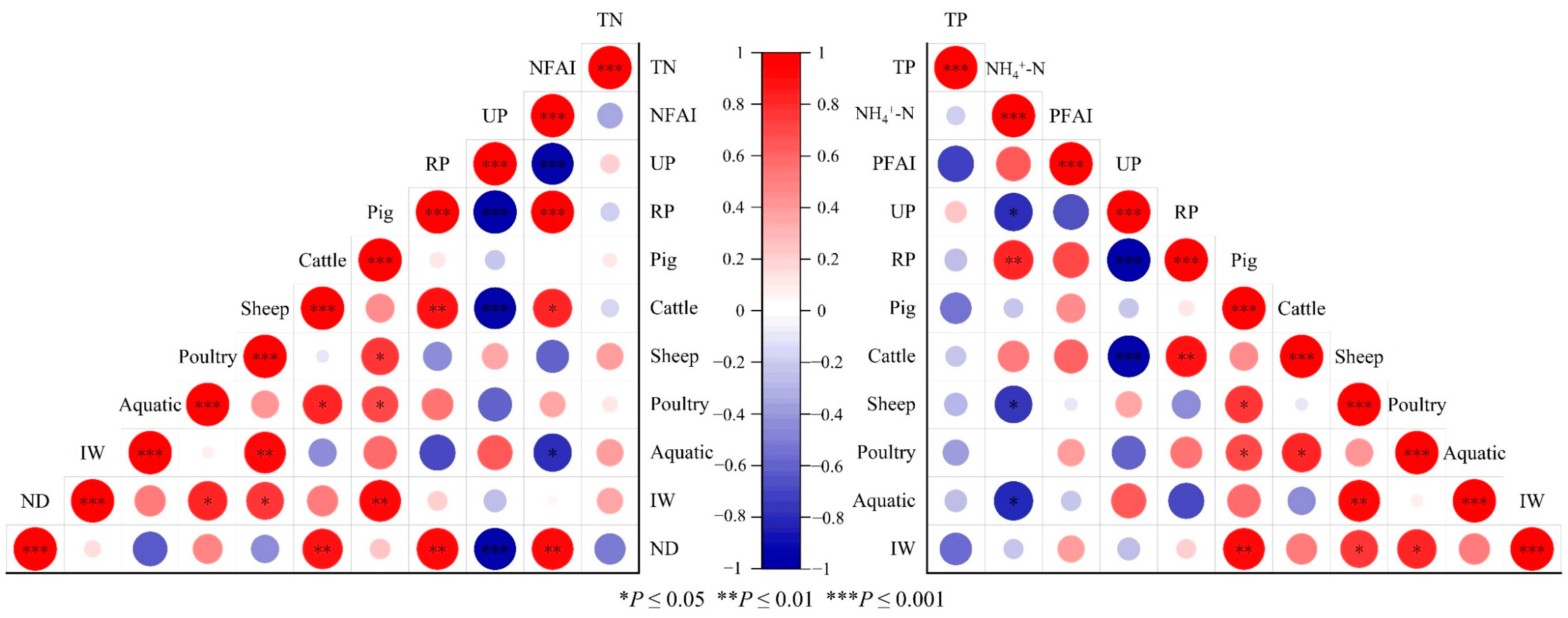
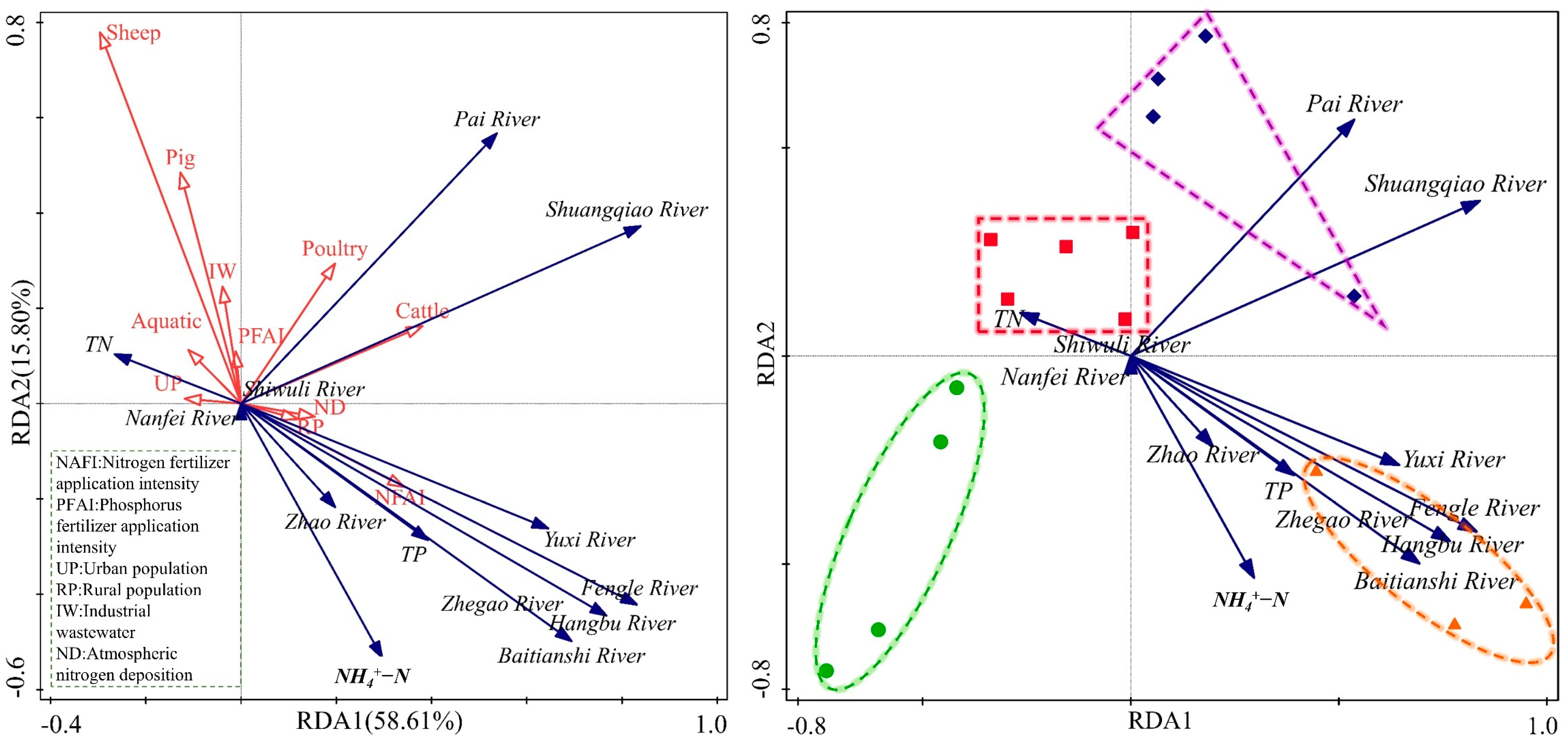
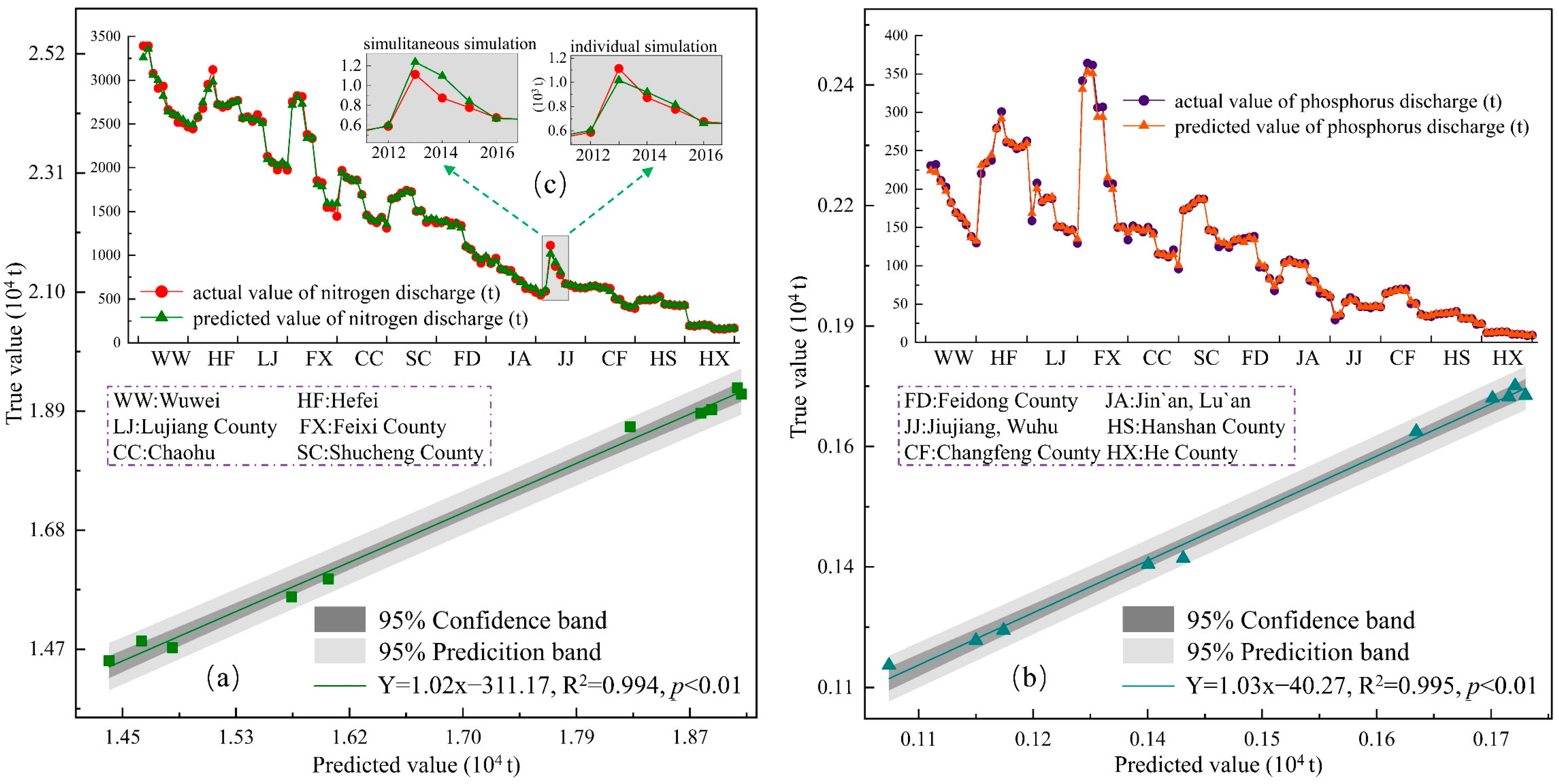
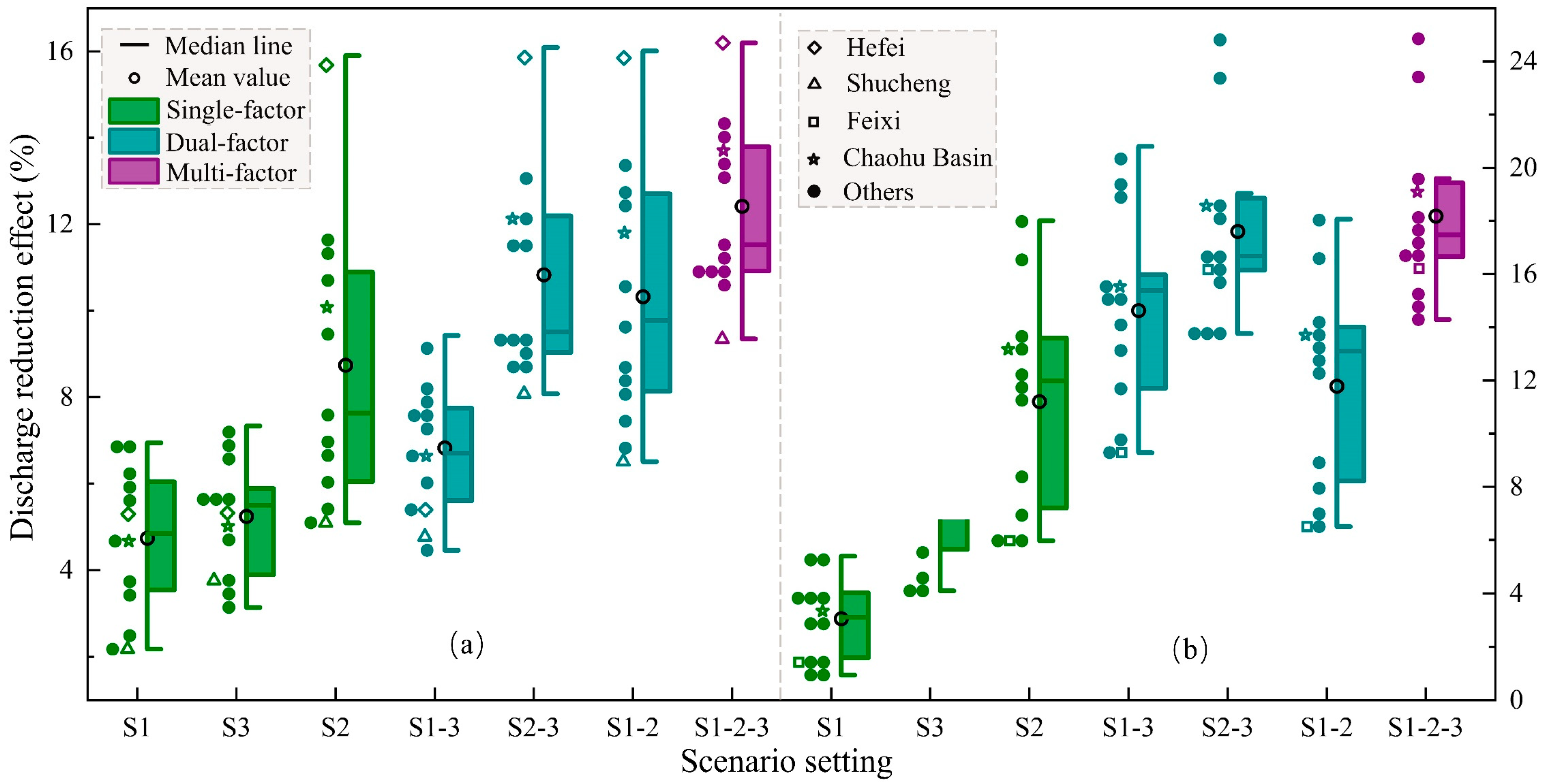
| Name | Abbreviation | Management Measures |
|---|---|---|
| Single-factor | S1 | fertilizer application |
| S2 | domestic sewage | |
| S3 | livestock breeding | |
| Dual-factor | S1-3 | fertilizer application and domestic sewage |
| S2-3 | domestic sewage and livestock breeding | |
| S1-2 | fertilizer application and domestic sewage | |
| Multi-factor | S1-2-3 | fertilizer application, domestic sewage, and livestock breeding |
Disclaimer/Publisher’s Note: The statements, opinions and data contained in all publications are solely those of the individual author(s) and contributor(s) and not of MDPI and/or the editor(s). MDPI and/or the editor(s) disclaim responsibility for any injury to people or property resulting from any ideas, methods, instructions or products referred to in the content. |
© 2023 by the authors. Licensee MDPI, Basel, Switzerland. This article is an open access article distributed under the terms and conditions of the Creative Commons Attribution (CC BY) license (https://creativecommons.org/licenses/by/4.0/).
Share and Cite
Chen, X.; Chen, S.; Wang, Y.; Jiang, L.; Huang, X.; Shahtahmassebi, A.; Dai, Z.; Cai, Z. Evaluating Effects of Nitrogen and Phosphorus Discharges under Different Reduction Scenarios: A Case of Chaohu Lake Basin, China. Agronomy 2023, 13, 3079. https://doi.org/10.3390/agronomy13123079
Chen X, Chen S, Wang Y, Jiang L, Huang X, Shahtahmassebi A, Dai Z, Cai Z. Evaluating Effects of Nitrogen and Phosphorus Discharges under Different Reduction Scenarios: A Case of Chaohu Lake Basin, China. Agronomy. 2023; 13(12):3079. https://doi.org/10.3390/agronomy13123079
Chicago/Turabian StyleChen, Xi, Sidi Chen, Yanhua Wang, Ling Jiang, Xiaoli Huang, AmirReza Shahtahmassebi, Zishuai Dai, and Zucong Cai. 2023. "Evaluating Effects of Nitrogen and Phosphorus Discharges under Different Reduction Scenarios: A Case of Chaohu Lake Basin, China" Agronomy 13, no. 12: 3079. https://doi.org/10.3390/agronomy13123079
APA StyleChen, X., Chen, S., Wang, Y., Jiang, L., Huang, X., Shahtahmassebi, A., Dai, Z., & Cai, Z. (2023). Evaluating Effects of Nitrogen and Phosphorus Discharges under Different Reduction Scenarios: A Case of Chaohu Lake Basin, China. Agronomy, 13(12), 3079. https://doi.org/10.3390/agronomy13123079






